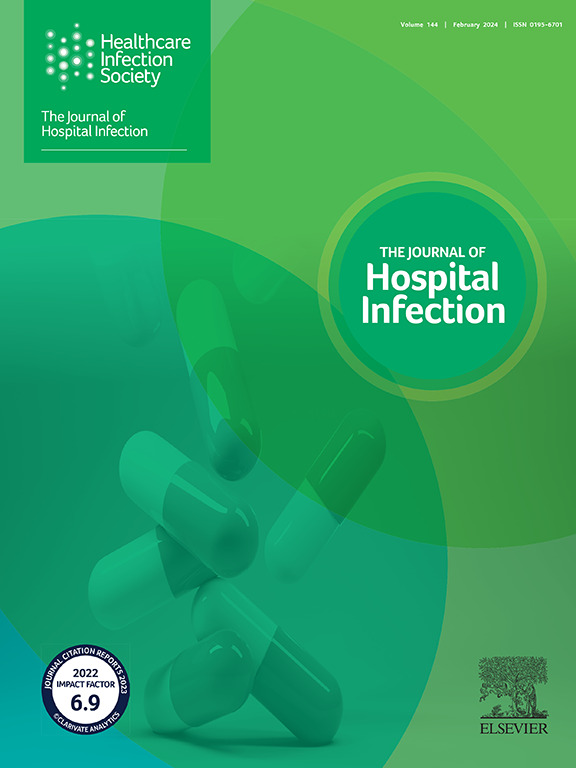Genotyping of Candida tropicalis isolates uncovers nosocomial transmission of two lineages in Italian tertiary care hospital
IF 3.9
3区 医学
Q1 INFECTIOUS DISEASES
引用次数: 0
Abstract
Objectives
Candida tropicalis is a medically important yeast with increasing antifungal resistance, but nosocomial transmission is rarely reported. This study genotyped C. tropicalis isolates from Italian hospitals to uncover potential nosocomial transmission and assess resistance.
Methods
In total, 197 C. tropicalis isolates from 161 patients were collected from five centres from 2013 to 2023. Short tandem repeat (STR) genotyping was conducted on all isolates, and a selection of 24 isolates were typed with whole-genome sequencing (WGS) and the novel Fourier-transform infrared (FTIR) spectroscopy method. Antifungal resistance was investigated with microbroth dilution and WGS.
Results
STR genotyping revealed seven clusters with isolates from multiple patients. WGS single nucleotide polymorphism (SNP) analysis on five groups of isolates with related STR genotypes also separated these isolates into five groups, of which two groups contained a cluster of isolates from different patients distinguished by ≤59 SNPs. In comparison, sequential isolates within three patients were differentiated by ≤141 SNPs. The two C. tropicalis WGS clusters also clustered based on FTIR genotyping, although this method did not separate the isolates into five groups. None of the 24 isolates were resistant to common antifungals.
Conclusions
WGS SNP analysis indicated nosocomial transmission of two lineages within the same hospital, highlighting the need for enforced infection prevention measures and routine genotyping on this common yeast in clinical settings. While both STR and FTIR genotyping also clustered these lineages, WGS SNP analysis is required to determine whether isolates were transmitted clonally.
对热带念珠菌分离株进行基因分型,发现意大利三级甲等医院存在两种菌系的院内传播。
目的:热带念珠菌是一种重要的医学酵母菌,其抗真菌耐药性不断上升,但很少有关于其在医院内传播的报道。在此,我们对来自意大利医院的热带念珠菌分离株进行了基因分型,以发现潜在的院内传播并评估耐药性:方法:从 2013 年到 2023 年,我们从 5 个中心收集了来自 161 名患者的 197 株热带真菌分离株。对所有分离株进行了短串联重复(STR)基因分型,并选择了 24 株分离株进行了全基因组测序(WGS)和新型傅立叶变换红外(FTIR)光谱法分型。采用微流稀释法和 WGS 对抗真菌耐药性进行了调查:结果:STR 基因分型发现了来自多名患者的七个分离菌群。对具有相关 STR 基因型的五组分离物进行的 WGS 单核苷酸多态性(SNP)分析也将这些分离物分成了五组,其中两组包含来自不同患者的分离物群,以 59 个或更少的 SNP 进行区分。相比之下,三个患者体内的连续分离物最多只有 141 个 SNPs。根据傅立叶变换红外(FTIR)基因分型,两个热带卷曲杆菌 WGS 群体也进行了聚类,不过这种方法并没有将分离物分成五组。24 个分离株中没有一个对普通抗真菌药具有抗药性:结论:WGS SNP 分析表明,在同一家医院内存在两个菌系的院内传播,这凸显了加强感染预防措施的必要性,以及在临床环境中对这种常见酵母菌进行常规基因分型的必要性。虽然STR和傅立叶变换红外光谱基因分型也对这些菌系进行了聚类,但还需要进行WGS SNP分析,以确定分离物是否进行了克隆传播。
本文章由计算机程序翻译,如有差异,请以英文原文为准。
求助全文
约1分钟内获得全文
求助全文
来源期刊

Journal of Hospital Infection
医学-传染病学
CiteScore
12.70
自引率
5.80%
发文量
271
审稿时长
19 days
期刊介绍:
The Journal of Hospital Infection is the editorially independent scientific publication of the Healthcare Infection Society. The aim of the Journal is to publish high quality research and information relating to infection prevention and control that is relevant to an international audience.
The Journal welcomes submissions that relate to all aspects of infection prevention and control in healthcare settings. This includes submissions that:
provide new insight into the epidemiology, surveillance, or prevention and control of healthcare-associated infections and antimicrobial resistance in healthcare settings;
provide new insight into cleaning, disinfection and decontamination;
provide new insight into the design of healthcare premises;
describe novel aspects of outbreaks of infection;
throw light on techniques for effective antimicrobial stewardship;
describe novel techniques (laboratory-based or point of care) for the detection of infection or antimicrobial resistance in the healthcare setting, particularly if these can be used to facilitate infection prevention and control;
improve understanding of the motivations of safe healthcare behaviour, or describe techniques for achieving behavioural and cultural change;
improve understanding of the use of IT systems in infection surveillance and prevention and control.
 求助内容:
求助内容: 应助结果提醒方式:
应助结果提醒方式:


